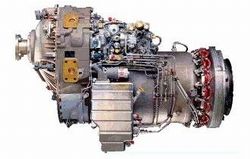Sun, May 30, 2010
Data Was Collected By A Research Aircraft That Flew 30 Hours
Through Ash Clouds
It's been a while since we've heard about widespread airspace
closures due to the eruption of the volcano in Iceland. But it's
certainly a question of when, rather than if, such an event
will happen in the future. And what has become evident is that much
more needs to be known about how volcanic ash affects turbine
aircraft engines. With that in mind, Honeywell said Thursday that
it will be analyzing the effects of ash ingestion in two of its
TPE331 turboprop engines which were used to gather scientific data
during the recent volcanic eruptions and flights into the
subsequent ash cloud over Europe.

TPE331 Engine
The engines powered a Dornier 228 and accumulated 10 hours of
operation in the volcanic ash cloud and an additional 22 hours of
operation in the outer zone of the cloud. The engines have been
returned to Phoenix, AZ for analytical teardown and
evaluation.
"The industry has little information on the effects of volcanic
ash ingestion in turbine engines and we hope the data we gain from
this effort will help define operational impact to the engine and
any damage to components," said Ronald J. Rich, Vice President,
Propulsion Systems, Honeywell Aerospace. "These volcanic eruptions
give us an opportunity to systematically analyze volcanic ash
impact to our engines and this examination could yield a basis for
future turbine engine performance and maintenance service
data."
The TPE331 powered aircraft operated by the Natural Environment
Research Council in the United Kingdom, was collecting particulate
data at one second intervals during their flights into the clouds.
The data includes composition of the debris along with navigational
and engine operational data.

Volcanic Ash Cloud Photo 4.17.10
Also known to have flown aircraft into and around the volcanic
plume is Germany's Deutsches Zentrum fur Luft- und Raumfahrt; DLR,
who operated a Falcon 20-5, powered by Honeywell's TFE-731-5BR
engines. The DLR is Germany's national research center for
aeronautics and space. DLR's extensive research and development
work in aeronautics, space, transportation and energy is integrated
into German and international cooperative ventures.
The British Met Office Information, a weather service
organization also flew its Honeywell ALF 502 powered BAE-146 around
the plume. The British Met office predicts weather for the United
Kingdom and is a significant contributor to the global
understanding of climate change and weather science.
More News
He Attempted To Restart The Engine Three Times. On The Third Restart Attempt, He Noticed That Flames Were Coming Out From The Right Wing Near The Fuel Cap Analysis: The pilot repor>[...]
Make Sure You NEVER Miss A New Story From Aero-News Network Do you ever feel like you never see posts from a certain person or page on Facebook or Instagram? Here’s how you c>[...]
From 2009 (YouTube Edition): Leading Air Show Performers Give Their Best Advice for Newcomers On December 6th through December 9th, the Paris Las Vegas Hotel hosted over 1,500 air >[...]
Aero Linx: NASA ASRS ASRS captures confidential reports, analyzes the resulting aviation safety data, and disseminates vital information to the aviation community. The ASRS is an i>[...]
“For our inaugural Pylon Racing Seminar in Roswell, we were thrilled to certify 60 pilots across our six closed-course pylon race classes. Not only did this year’s PRS >[...]
 NTSB Final Report: Rutan Long-EZ
NTSB Final Report: Rutan Long-EZ ANN FAQ: Turn On Post Notifications
ANN FAQ: Turn On Post Notifications Classic Aero-TV: ICAS Perspectives - Advice for New Air Show Performers
Classic Aero-TV: ICAS Perspectives - Advice for New Air Show Performers ANN's Daily Aero-Linx (06.28.25)
ANN's Daily Aero-Linx (06.28.25) Aero-News: Quote of the Day (06.28.25)
Aero-News: Quote of the Day (06.28.25)




